Great video highlighted in the New York Times Today on retirement:
|
|
Great video highlighted in the New York Times Today on retirement:
|
|
*This is a supplement post of the Analogous Immersion done by Alex Charron and Joe Krause in the perspective of Joe.
Date: 3/3/17
Type: Analogous Immersion
Location; Mishawaka Chick Fil A
Participants: Alexandra Charron and Joe Krause
The team visited the Mishawaka Chick Fil A (CFA) in order to gain knowledge regarding Chick Fil A’s catering and delivery process. The team spoke with Ron Taylor, the assistant manager of the Mishawaka branch.
Additionally, Alex researched the online ordering process, while Joe called the store to research the call in ordering process. It was a similar booking process accept an employee enters in the order information instead of the customer online.
Top Learnings:
Key Insights:
*Photos of the team’s analogous immersion, along with additional data and Alex’s perspective, are displayed below on a blog post from Alex.
*This post is supplemental info from the Interactive Ethnographic Research done by Alex and Joe. (Joe’s perspective)
Interactive Ethnography
Date: 3/3/17
Location: St Joseph Health Systems Mishawaka Medical Center.
Participants: Alexandra Charron and Joe Krause
As described in a recent post, the team went to Saint Joseph’s Regional Medical Center and conducted interactive research by having people identify their transportation issues on a journey map. The team asked a total of 9 people, “Do you ever face problems in the process of getting to a medical appointment?” They then handed them a journey map and had them mark an X where they faced problems.
This was a great way to gain anonymous information from people, especially since lack of access to transportation can be a touchy subject. The team made sure to ask people of different demographics in order to understand various perspectives.
Key insights:
A more detailed summary of the interactive is displayed below in a blog post by Alex Charron, along with various pictures of the research.
The teams originally journey map is also attached below this blog post.
Name: Alex
Age: 57
Homeless Status: Newly Homeless
Employment Status: Employed, Full-Time
Hometown: South Bend
Location: Kraz Weather Amnesty Building
Date of Interview: February 16, 2017
Key takeaways:
Notable Quotations
“Its nice in here, everyone behaves themselves because no one wants to get kicked out.”
“Alcoholism and drug addiction don’t discriminate against finance and economics.”
Name: Debbie
Hometown: South Bend
Date of Observation: February 16, 2017
Location: Kraz Weather Amnesty Building
Type of Observation: Interview
A member of The Vineyard Church who helps out Weather Amnesty
Key Takeaways:
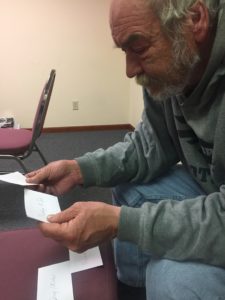
Name: Ed King
Age: 61
Time spent homeless: 8 years
Time in weather amnesty program: 3 years
Employment status: Unemployed
Blind in left eye, needs surgery to correct
Previously Vietnam veteran & in uniform business
Date of Observation: March 2, 2017
Location: Kraz Weather Amnesty Building
Type of Observation: User + Interactive Interview
Ed went through a devastating divorce and had to quit his job to enter inpatient psychiatric services. He struggled to re-enter the job market afterwards. He cannot see out of his left eye and has difficulty walking, which makes it difficult for him to find work. He needs surgery on his left eye, but does not currently have insurance that will cover it.
2. Gave up looking for work
Ed is blind in one eye and has difficulty walking. This has deterred him from job-searching, and instead he spends his time drinking on the corner.
3. Desire for Independence
Ed went through the Center for the Homeless programming, but does not want to return because he felt they interfered with his personal life too much.
4. Isolation from family
Ed’s journey into homelessness was catalyzed by a devastating divorce. His wife left him, taking the kids, home, and money. She completely shut him out of their lives, so Ed has no family in his life right now. Missing his children left him depressed and with few people to turn to.
“I wish I could put family at the top, but they’re not in the picture anymore.”
“The only thing I had was my dog and my house, but she ended up taking that too.”
“I’m 62 years old. I just gotta stick it out for 2 more years until I retire.”
“Good days are all the same. I have a couple beers a day. I never drank before, but now I’m drinking a lot more than I used to cause that’s what keeps it coherent. I don’t even know what would make a bad day anymore. They’re all bad.“
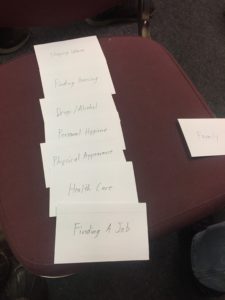
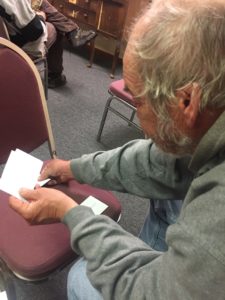
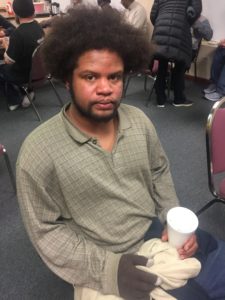
Name: Silas Elliott
Age: 27
Time spent homeless: 3 years
Current employment status: Unemployed
Has a love for pets
Date of Observation: March 3, 2017
Location: Weather Amnesty Shelter
Type of Observation: User + Interactive Interview
1. Denial of drug addiction
Silas has used drugs since the age of 14. He has been to rehab twice, but continues to use drugs. He does not think of himself as an addict, but he was intoxicated at the time of the interview to the point where he was incoherent.
2. Spending the day on the corner
Silas says he spends most of his day standing on the corner asking for money. Sometimes he also looks for work and other ways to make money, but he is currently unemployed.
3. Lacking self-awareness
Silas described himself as “hard working” and “disciplined.” This seemed to contradict his behaviors of drug use and begging on the corner.
“I was not on the verge of ‘addicacy.’ I’m not an addict, not technically. I’m like half and half.”
“My mom thinks I’m an addict. But I know that I don’t have a problem. It’s been bad before, but right now, I’m not an addict.”
“During the day, I stand on the corner and ask for money.”
Sort into words that describe you & words that do not. Rank from best to least descriptive in each category.
Words Silas believes describes him:
Words he does not believe describe him:
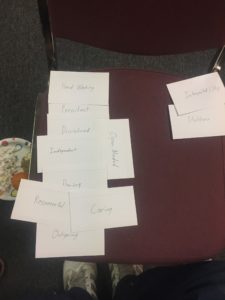
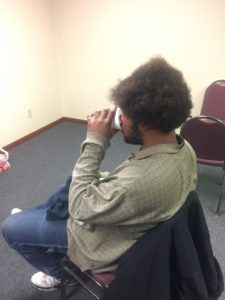
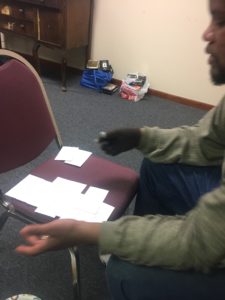
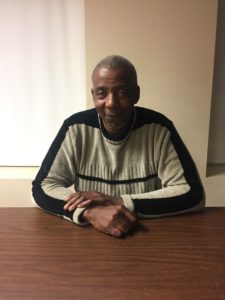
Name: David Fayne
Age: 58
Time spent homeless: 6 years
Time in weather amnesty program: 3 weeks
Hometown: Elkhart
Employment status: Unemployed
Date of Observation: February 16, 2017
Location: Kraz Weather Amnesty Building
Type of Observation: Interview
1. South Bend services are insufficient.
David previously lived in Salt Lake City and experienced the Housing First model. He feels there need to be more accessible services similar to this. He does not like that there are so many barriers to entering the shelter programs. He also dislikes that the weather amnesty shelter is temporary, and it is only accessible from 8pm to 8am.
2. The drive for improvement
David showed a passion for improving the homeless community. He dreamed of creating a 24-hour shelter/center for the homeless that would choose to help, rather than turn away, people with issues like substance abuse. He was determined to talk to local politicians, churches, and university resources about his idea.
3. Optimism for the future
David felt confident in himself that he would be able to find a job and housing soon and start implementing his ideas for improvement.
“Having a place where people could stay 24 hours would be more sufficient than spending money on these seasonal programs because we could get to deal with people and we could get to place people.”
“By people jumping around like popcorn, they’re never going to get the help they need. They’re never going to be in the facility long enough to figure out what their problem is.
“You’re gonna have to let the drug addicts in if you want to help them.”
For my immersion experience, I visited the weather amnesty shelter in the Kraz building in downtown South Bend. Below is a summary of my experience outlined in the Compelling Experience Framework:
Entice:
-No strings attached
The weather amnesty program differs from the other downtown shelters in two major ways: it is temporary (only in cold winter months) and it has very few requirements for entry. The weather amnesty is open to any homeless male, regardless of if he is drunk, high, pursuing jobs, or not. The tolerance of the shelter is what makes it so appealing for many homeless. The Center for the Homeless and HOPE ministries have requirements for anyone who enters the shelter, including a long-term commitment to their programming and staying free of drugs/alcohol. These rules can become barriers for homeless that are not ready to make those commitments.
-Provides warmth, shelter, snacks for free
The weather amnesty program provided about 30 simple cots and blankets on the floor in the back room. While it was nothing fancy, it would certainly be better than sleeping on the street. I felt safe while I was there, knowing that the staff are there to provide protection and to screen for any weapons before other homeless enter.
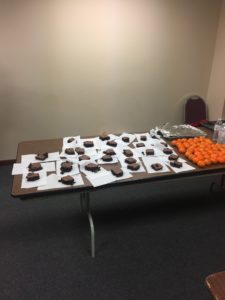
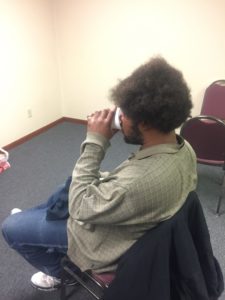
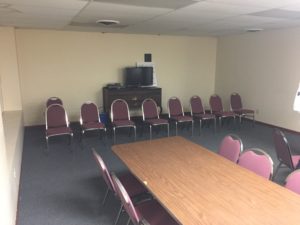
-Convenient location
The weather amnesty building is located downtown right next to the soup kitchen that provides dinner, making it a two minute, easy walk.

Enter:
-Staff checks for illict items
Anyone who wants to use the shelter must surrender any drugs or weapons before entering. This is for the safety of everyone in the shelter.
-Claim a cot
Typically, the homeless person will claim their cot after they enter to make sure that they get one before the shelter fills up.
-Giveaway of donated clothing items
The staff will pass out donated items, such as jeans, t-shirts, and coats, to whoever needs it.
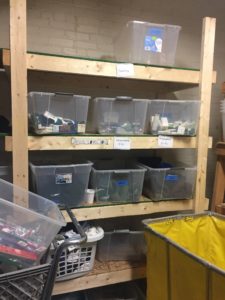
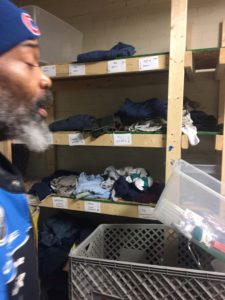
Engage:
-Snacks
-TV / VCR
-Fellowship
-Prayer & reflection led by volunteers
-Sleeping in the room
The common room was set up with chairs, a TV with a VCR, and a table for snacks. Volunteers from a local church brought in oranges, popcorn, and coffee for the snack, and they led the group in prayer. About half of the people there went to the prayer, and several specifically asked to be prayed over. The volunteers played euchre with two of the homeless men. Most other people watched TV, spent time on their phones (if they had one), or just ate their snack and kept to themselves. Some of the people there were outgoing and friendly, some were very introverted and irritable, others were high. There wasn’t a sense of larger tight-knit community, but some of the men had become friends and were chatting in the common room.
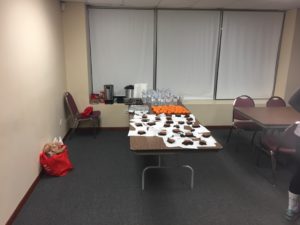
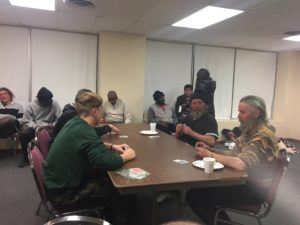
Exit:
-Leave by 8AM
All homeless must leave the building by 8am. They typically walk down the street to a local church for free breakfast.
Extend:
-Spread by word of mouth
Homeless people typically learn about resources, like the weather amnesty shelter, through word of mouth from other homeless who have used it. The people at the shelter can spread word to other people in the homeless community this way.
29 from south bend
Adam has recently turned to homelessness. Unlike many, he has never been addicted to drugs or alcohol. He recently lost his house and quit his job. He told him that God had told him to not worry about letting go of all of his material possessions and just to trust Him.
Until recently, Adam worked with mental health patients. I am not sure of what his exact title was but he said that he enjoyed forming relationships with his patients a lot better than interacting with his coworkers. After some of his patients passed, he said that he quit his job because he felt that he could not give his patients his best self and had too much going on with his family. After quitting his job he shortly lost his house as well.
Adam told us that when his house and all of his other possessions started to slip away, God told him just to let go and that everything would be ok. Adam was very emotional throughout this whole interview almost coming to tears multiple times. When I asked what he thought God had in store for him next, he said that he had no idea and was just trying to take it day by day.
Interactive Card Sort:
I did an Interactive Card sort with Adam. He seemed very confident in what he thought that the order of his words were. The card sort that we gave him was a bunch of words and we asked him what words he thought described himself the best. To my surprise, towards the top he put outgoing, which was odd to me because he was quite shy. I guess that talking to complete strangers is something that most people wouldn’t do.
The main takeaway that I took from Adam was that he was really mentally shaken about his situation. When I talked with him about how he became homeless, he really got emotional and almost broke out into tears. He is clearly someone that would need some sort of counseling help to get his mind right again. He is an example of a cause of homelessness that didn’t cross our minds from the beginning.
47 years old from Niles
Same Location as above
2nd night at the weather amnesty center. He seems to have some kind of problem at home and left the house. Used to be a very heaving drinker, which has led him to have scerosis, spinal injury, and many other health issues. Grew up in California where his father was a belligerent drunk.
Other than his father being an abusive drunk, his mother recently died of cancer and his girlfriend has MS. He has a spinal injury where he is unable to move his right arm without assistance. He has scerosis from excessive drinking and smoking. He also has 3 kids that are 16,15, and 7 with different women.
Marty claims to be a very quick learner. He seemed to want to talk about every subject that he could. His next steps were trying to find a job where he can support his family better. He also wanted to get an operation on his spine so he can use his right arm again.
53 from Houston, involved in Gangs and Drug Trafficking
Didn’t have a father and didn’t have a good relationship with his mother so he got involved with a gang when he was in middle school.
Has spent 30 of 53 years in prison for drugs, attempted murder, and various other gang related charges. He is on parole and involved with Hope because he was selling cocaine in South Bend. Brought a stripper back to his room and she was tryin to by cocaine from him, he refused and she tipped the cops. He has been in jail for 2 and ½ years and now graduated hope program and done in December.
When I asked if he was glad that it happened he at first said no but then responded yes because it allowed him to get out of his vicious cycle of selling drugs and gangs. He is now enrolled in school and wants to go around to schools and help kids in Houston with the same problems he had. Every chance he gets he kept showing me his school ID on his phone and was very excited to start school in April.
Junior High Teacher
How He Got Started with this Work
Randy is a junior high teacher at the Montessori school. He has been a long time volunteer with the Center for the Homeless and he actually brings a group of 8th graders to the center every Wednesday to help with the Pre-k program at the Center. He started this by knowing Steve, which gave him the connection to start this program through the school. He said that this program really helps educate his kids, himself, as well as obviously help educate the children that are at the Center for the Homeless.
His thoughts on Barriers
He had two main barriers for people choosing to stay homeless. 1) drug and alcohol abuse is extreme. He said that he doesn’t think that everyone is ready to get the help that they need and they refuse to get off of the streets because they know that they can use their substances there without any pushback. 2) Capacity. He said that there are so many people that come to the Center and use similar resources that there are just not enough for the whole homeless population. He also put a special emphasis on families and the fact that families may not want to come into the Center because they men and women will get split up at night because of the rules of the Center.
Randy gave a very valuable perspective about his view on the homeless situation. From the view of a volunteer who also has some experience working with city councils and such, he seemed to want to stress a housing first method but was unsure how to educate taxpayers how this method will reduce costs in the long run while keeping homeless people off the streets. He understood that not everyone has the most empathy towards homeless people and wanted to figure a way to educate the average person on the situation.
For my immersion I went to the bridge site where tent city had been previously set up this past summer. What I witnessed there was quite similar to what I imagined there would be. There were broken bottles of alcohol lying next to empty bags of chips and other various types of packaged food. There was a large cardboard box torn open and dirty with some alcohol bottles,a syringe, and some tattered clothes. As I was walking around taking pictures (which for some reason I am unable to upload because it is saying that the files are too big) a group of homeless people were sitting around in a circle. They seemed to be boozing it up and once they spotted me, they started shouting and cussing. I promptly went back into my car and drove away.
So for my analogous immersion I interviewed one of my teammates that is from Great Britain. WE thought that a foreign student would be a good person to interview because it is similar in the way that they may not be aware of the resources that they have available and that they may have to deal with a major cultural difference moving to a different country. The main takeaways that I had from Dan’s interview and his experience going to school in a different country is that he definitely had a big adjustment to being a student athlete at in America. It was crucial for him to learn about the resources that he needed to help him succeed. He also said that the cultural difference was a slight barrier but for the major part the cultures are rather similar and not a huge barrier for his success in America.
The major takeaway from this is that the education of resources for Dan was essential. Education plays a major role in our problem because we need to educate the homeless about the available resources but also we need to educate the citizens of South Bend that there is a huge cost advantage to giving these homeless people the help that they need now in order to get them to stop using resources and tax money in the future.
This research showed me that these people don’t want to be a spectacle. It made me realize that they are just regular people with some not regular problems. At one point all of them were just regular school kids doing things that I used to do when I was younger. Homeless people come from all types of backgrounds. Whether they were affluent or poor, had both parents or none, or graduated college or didn’t make it our of the 5th grade, the important thing is that they are people too and should be treated like so. I feel we are guilty of treating homeless people as some kind of spectacle or just something that we try not to make eye contact with at a stoplight. The only way that this problem will be solved is if we treat homeless people not as some circus act, but as if they were our own friends who just made a few bad decisions.